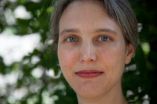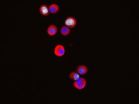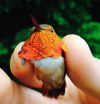(Press-News.org) For many years scientists have been trying to unravel mechanisms that guide function and differentiation of blood stem cells, those cells that generate all blood cells including our immune system. The study of human blood stem cells is difficult because they can only be found in the bone marrow in specialized "niches" that cannot be recapitulated in a culture dish. Now a group of scientists from Dresden led by stem cell researcher Prof. Claudia Waskow (Technische Universität Dresden) was able to generate a mouse model that supports the transplantation of human blood stem cells despite the species barrier and without the need for irradiation. They used a mutation of the Kit receptor in the mouse stem cells to facilitate the engraftment of human cells. In the new model human blood stem cells can expand and differentiate into all cell types of the blood without any additional treatment. Even cells of the innate immune system that can normally not be found in "humanized" mice were efficiently generated in this mouse. Of significance is the fact that the stem cells can be maintained in the mouse over a longer period of time compared to previously existing mouse models. These results were now published in the renowned journal "Cell Stem Cell".
"Our goal was to develop an optimal model for the transplantation and study of human blood stem cells," says Claudia Waskow, who recently took office of the professorship for "animal models in hematopoiesis" at the medical faculty of the TU Dresden. Before, Prof. Waskow was a group leader at the DFG-Center for Regenerative Therapies Dresden where most of the study was conducted. The trick used by Claudia Waskow's team to achieve optimal stem cell engraftment was the introduction of a naturally occurring mutation of the Kit receptor into mice that lack a functional immune system. This way they circumvented the two major obstacles of blood stem cell transplantation: the rejection by the recipient's immune system and absence of free niche space for the incoming donor stem cells in the recipient's bone marrow. Space is usually provided by irradiation therapy, called conditioning, because it damages and depletes the endogenous stem cells and thus frees space for the incoming human cells. However, irradiation is toxic to many cell types and can lead to strong side effects. The Kit mutation in the new mouse model impairs the recipient's stem cell compartment in such a way that the endogenous blood stem cells can be easily replaced by human donor stem cells with a functional Kit receptor. This replacement works so efficiently that irradiation can be completely omitted allowing the study of human blood development in a physiological setting. The model can now be used to study diseases of the human blood and immune system or to test new treatment options.
The results from Prof. Waskow's group also show that the Kit receptor is important for the function of human blood stem cells, notably in a transplantation setting. Further studies will now focus on using this knowledge about the role of the receptor to improve conditioning therapy in the setting of therapeutic hematopoietic stem cell transplantation in patients.
INFORMATION: END
Opening-up the stem cell niche
Hematopoietic stem cell transplantation without irradiation
2014-07-11
ELSE PRESS RELEASES FROM THIS DATE:
Baboons groom early in the day to get benefits later
2014-07-11
Social animals often develop relationships with other group members to reduce aggression and gain access to scarce resources. In wild chacma baboons the strategy for grooming activities shows a certain pattern across the day. The results are just published in the scientific journal Biology Letters.
Grooming between individuals in a group of baboons is not practiced without ulterior motives. To be groomed has hygienic benefits and is stress relieving for the individual, while grooming another individual can provide access to infants, mating opportunities and high quality ...
A first direct glimpse of photosynthesis in action
2014-07-11
An international team of researchers, including scientists from the Max Planck Institute for Medical Research in Heidelberg, has just a reported a major step in understanding photosynthesis, the process by which the Earth first gained and now maintains the oxygen in its atmosphere and which is therefore crucial for all higher forms of life on earth.
The researchers report the first direct visualization of a crucial event in the photosynthetic reaction, namely the step in which a specific protein complex, photosystem II, splits water into hydrogen and oxygen using energy ...
Molecular snapshots of oxygen formation in photosynthesis
2014-07-11
Researchers from Umeå University, Sweden, have explored two different ways that allow unprecedented experimental insights into the reaction sequence leading to the formation of oxygen molecules in photosynthesis. The two studies have been published in the scientific journal Nature Communications.
"The new knowledge will help improving present day synthetic catalysts for water oxidation, which are key components for building artificial leaf devices for the direct storage of solar energy in fuels like hydrogen, ethanol or methanol," says Johannes Messinger, Professor in ...
3-D technology used to help California condors and other endangered species
2014-07-11
A team including researchers from the U.S. Geological Survey (USGS) and the San Diego Zoo Institute for Conservation Research has developed a novel methodology that, for the first time, combines 3-D and advanced range estimator technologies to provide highly detailed data on the range and movements of terrestrial, aquatic, and avian wildlife species. One aspect of the study focused on learning more about the range and movements of the California condor using miniaturized GPS biotelemetry units attached to every condor released into the wild.
"We have been calculating ...
USC stem cell researcher targets the 'seeds' of breast cancer metastasis
2014-07-11
For breast cancer patients, the era of personalized medicine may be just around the corner, thanks to recent advances by USC Stem Cell researcher Min Yu and scientists at Massachusetts General Hospital and Harvard Medical School.
In a July 11 study in Science, Yu and her colleagues report how they isolated breast cancer cells circulating through the blood streams of six patients. Some of these deadly cancer cells are the "seeds" of metastasis, which travel to and establish secondary tumors in vital organs such as the bone, lungs, liver and brain.
Yu and her colleagues ...
Precipitation, not warming temperatures, may be key in bird adaptation to climate change
2014-07-11
CORVALLIS, Ore. – A new model analyzing how birds in western North America will respond to climate change suggests that for most species, regional warming is not as likely to influence population trends as will precipitation changes.
Several past studies have found that temperature increases can push some animal species – including birds – into higher latitudes or higher elevations. Few studies, however, have tackled the role that changes in precipitation may cause, according to Matthew Betts, an Oregon State University ecologist and a principal investigator on the study.
"When ...
Do women perceive other women in red as more sexually receptive?
2014-07-11
Previous research has shown that men perceive the color red on a woman to be a signal of sexual receptivity. Women are more likely to wear a red shirt when they are expecting to meet an attractive man, relative to an unattractive man or a woman. But do women view other women in red as being more sexually receptive? And would that result in a woman guarding her mate against a woman in red? A study published in Personality and Social Psychology Bulletin sought to answer these questions.
Perceptions of Sexual Receptivity
Nonverbal communication via body language, facial ...
ACL reconstructions may last longer with autografts
2014-07-11
SEATTLE, WA – Anterior Cruciate Ligament (ACL) reconstructions occur more than 200,000 times a year, but the type of material used to create a new ligament may determine how long you stay in the game, say researchers presenting their work today at the Annual Meeting of the American Orthopaedic Society of Sports Medicine (AOSSM).
"Our study results highlight that in a young athletic population, allografts (tissue harvested from a donor) fail more frequently than using autografts (tissue harvested from the patient)," said Craig R. Bottoni, MD, lead author from Tripler ...
New study may identify risk factors for ACL re-injury
2014-07-11
SEATTLE, WA – Re-tearing a repaired knee Anterior Cruciate Ligament (ACL) happens all too frequently, however a recent study being presented today at the American Orthopaedic Society for Sports Medicine's (AOSSM) Annual Meeting suggests that identification and patient education regarding modifiable risk factors may minimize the chance of a future ACL tear.
"Our research suggests that a few risk factors such as, age, activity level and type of graft utilized may point to the possibility of re-injury," said lead author, Christopher C. Kaeding, MD of the Ohio State University. ...
Potent spider toxin 'electrocutes' German, not American, cockroaches
2014-07-11
Using spider toxins to study the proteins that let nerve cells send out electrical signals, Johns Hopkins researchers say they have stumbled upon a biological tactic that may offer a new way to protect crops from insect plagues in a safe and environmentally responsible way.
Their finding—that naturally occurring insect toxins can be lethal for one species and harmless for a closely related one—suggests that insecticides can be designed to target specific pests without harming beneficial species like bees. A summary of the research, led by Frank Bosmans, Ph.D., an assistant ...
LAST 30 PRESS RELEASES:
Interaction of climate change and human activity and its impact on plant diversity in Qinghai-Tibet plateau
From addressing uncertainty to national strategy: an interpretation of Professor Lim Siong Guan’s views
Clinical trials on AI language model use in digestive healthcare
Scientists improve robotic visual–inertial trajectory localization accuracy using cross-modal interaction and selection techniques
Correlation between cancer cachexia and immune-related adverse events in HCC
Human adipose tissue: a new source for functional organoids
Metro lines double as freight highways during off-peak hours, Beijing study shows
Biomedical functions and applications of nanomaterials in tumor diagnosis and treatment: perspectives from ophthalmic oncology
3D imaging unveils how passivation improves perovskite solar cell performance
Enriching framework Al sites in 8-membered rings of Cu-SSZ-39 zeolite to enhance low-temperature ammonia selective catalytic reduction performance
AI-powered RNA drug development: a new frontier in therapeutics
Decoupling the HOR enhancement on PtRu: Dynamically matching interfacial water to reaction coordinates
Sulfur isn’t poisonous when it synergistically acts with phosphine in olefins hydroformylation
URI researchers uncover molecular mechanisms behind speciation in corals
Chitin based carbon aerogel offers a cleaner way to store thermal energy
Tracing hidden sources of nitrate pollution in rapidly changing rural urban landscapes
Viruses on plastic pollution may quietly accelerate the spread of antibiotic resistance
Three UH Rainbow Babies & Children’s faculty elected to prestigious American Pediatric Society
Tunnel resilience models unveiled to aid post-earthquake recovery
Satellite communication systems: the future of 5G/6G connectivity
Space computing power networks: a new frontier for satellite technologies
Experiments advance potential of protein that makes hydrogen sulfide as a therapeutic target for Alzheimer’s disease
Examining private equity’s role in fertility care
Current Molecular Pharmacology achieves a landmark: real-time CiteScore advances to 7.2
Skeletal muscle epigenetic clocks developed using postmortem tissue from an Asian population
Estimating unemployment rates with social media data
Climate policies can backfire by eroding “green” values, study finds
Too much screen time too soon? A*STAR study links infant screen exposure to brain changes and teen anxiety
Global psychiatry mourns Professor Dan Stein, visionary who transformed mental health science across Africa and beyond
KIST develops eco-friendly palladium recovery technology to safeguard resource security
[Press-News.org] Opening-up the stem cell nicheHematopoietic stem cell transplantation without irradiation



